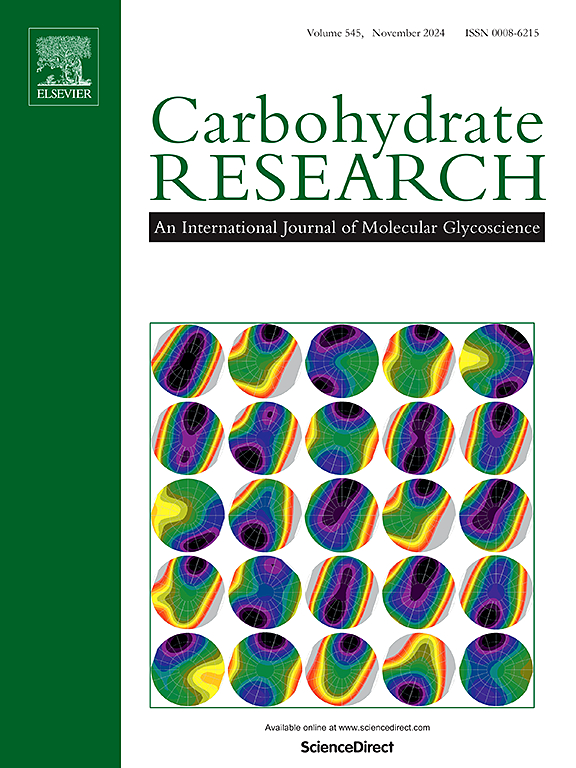Quaternary ammonium salts of chitosan containing aromatic ring: Synthesis, characterization, antimicrobial, antioxidant and cytotoxicity
IF 2.4
3区 化学
Q3 BIOCHEMISTRY & MOLECULAR BIOLOGY
引用次数: 0
Abstract
Quaternary ammonium salts of chitosan have been widely used in the development of anti-microbial biomaterials for their important role in inhibiting the growth of microorganisms. However, it is important to modify its structure to obtain more efficient and biologically active derivatives. Herein, a series of chitosan derivatives with antibacterial, antifungal, antioxidant, and non-cytotoxic properties was synthesized. These four quaternary ammonium salts of chitosan were prepared by incorporating 2-thiophenecarboxaldehyde, 2-furancarboxaldehyde, 2-pyridinecarboxaldehyde and benzaldehyde to form Schiff bases, followed by a reductive amination to obtain the chitosan N-derivatives, and quaternized by iodomethane. The inhibition rate of thiophenecarboxaldehyde chitosan trimethyl ammonium iodide (TpTMC) to B. cinerea could reach 93.78 % and the inhibition ability of pyridinecarboxaldehyde chitosan trimethyl ammonium iodide (PyTMC) to F. graminearum could reach 98.08 % at the concentration of 1.0 mg/mL. Furthermore, furancarboxaldehyde chitosan trimethyl ammonium iodide (FrTMC) exhibited a strong ability to scavenge hydroxyl radicals and DPPH radicals, especially the DPPH radicals scavenging ability was comparable to that of l-ascorbic acid at the concentration of 1.6 mg/mL. The B3LYP/6–311++G (d,p) basis set was employed to determine electronic properties, including HOMO-LUMO energies, and to analyze the chemical reactivity of the compounds. L929 cells were used to evaluate the cytotoxicity of the compounds at different concentrations (1−1000 μg/mL). The results demonstrated the diverse applications of aromatic ring-modified quaternary ammonium salts of chitosan, along with their significant antioxidant and antifungal effects against plant fungi. Therefore, these compounds have potential applications in the preparation of agricultural, biological, and medical materials.

含芳香环的壳聚糖季铵盐:合成、表征、抗菌、抗氧化和细胞毒性
壳聚糖的季铵盐因其在抑制微生物生长方面的重要作用而被广泛用于抗微生物生物材料的开发。然而,改变壳聚糖的结构以获得更高效、更具生物活性的衍生物非常重要。在此,我们合成了一系列具有抗菌、抗真菌、抗氧化和无细胞毒性特性的壳聚糖衍生物。这四种壳聚糖季铵盐是通过加入 2-噻吩甲醛、2-呋喃甲醛、2-吡啶甲醛和苯甲醛形成希夫碱,然后进行还原胺化得到壳聚糖 N-衍生物,并用碘甲烷进行季铵化而制得的。当噻吩甲醛壳聚糖三甲基碘化铵(TpTMC)的浓度为 1.0 毫克/毫升时,其对 B. cinerea 的抑制率可达 93.78%;吡啶甲醛壳聚糖三甲基碘化铵(PyTMC)对 F. graminearum 的抑制能力可达 98.08%。此外,呋喃甲醛壳聚糖三甲基碘化铵(FrTMC)还具有很强的清除羟基自由基和 DPPH 自由基的能力,尤其是在浓度为 1.6 mg/mL 时,其清除 DPPH 自由基的能力与抗坏血酸相当。采用 B3LYP/6-311++G (d,p) 基集确定了化合物的电子特性,包括 HOMO-LUMO 能量,并分析了化合物的化学反应活性。研究人员使用 L929 细胞评估了不同浓度(1-1000 μg/mL)化合物的细胞毒性。研究结果表明,芳香环修饰的壳聚糖季铵盐具有多种用途,对植物真菌具有显著的抗氧化和抗真菌作用。因此,这些化合物在制备农业、生物和医疗材料方面具有潜在的应用价值。
本文章由计算机程序翻译,如有差异,请以英文原文为准。
求助全文
约1分钟内获得全文
求助全文
来源期刊

Carbohydrate Research
化学-生化与分子生物学
CiteScore
5.00
自引率
3.20%
发文量
183
审稿时长
3.6 weeks
期刊介绍:
Carbohydrate Research publishes reports of original research in the following areas of carbohydrate science: action of enzymes, analytical chemistry, biochemistry (biosynthesis, degradation, structural and functional biochemistry, conformation, molecular recognition, enzyme mechanisms, carbohydrate-processing enzymes, including glycosidases and glycosyltransferases), chemical synthesis, isolation of natural products, physicochemical studies, reactions and their mechanisms, the study of structures and stereochemistry, and technological aspects.
Papers on polysaccharides should have a "molecular" component; that is a paper on new or modified polysaccharides should include structural information and characterization in addition to the usual studies of rheological properties and the like. A paper on a new, naturally occurring polysaccharide should include structural information, defining monosaccharide components and linkage sequence.
Papers devoted wholly or partly to X-ray crystallographic studies, or to computational aspects (molecular mechanics or molecular orbital calculations, simulations via molecular dynamics), will be considered if they meet certain criteria. For computational papers the requirements are that the methods used be specified in sufficient detail to permit replication of the results, and that the conclusions be shown to have relevance to experimental observations - the authors'' own data or data from the literature. Specific directions for the presentation of X-ray data are given below under Results and "discussion".
 求助内容:
求助内容: 应助结果提醒方式:
应助结果提醒方式:


